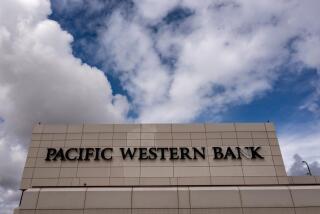The Wells Fargo-First Interstate Merger : COMMUNITY IMPACT : Bank Would Be Held to Its Loan Promise
- Share via
Now that a merger agreement between Wells Fargo and First Interstate has finally been hammered out, community groups vow to hold Wells to its 10-year, $45-billion promise to boost consumer, housing and small-business lending in neglected and minority neighborhoods.
The Greenlining Institute, which helped negotiate the commitment from Wells Fargo Chairman Paul Hazen, said it will meet quarterly with Wells managers to audit and review the bank’s progress in fulfilling its commitments.
Two of those quarterly meetings will be with Hazen himself, said Greenlining Director John Gamboa in San Francisco.
“We’re really confident [the bank will come through] . . . simply because it’s a personal commitment from Paul Hazen himself,” Gamboa said. “That means more than any contract.”
Beyond that, the federal Office of the Comptroller of the Currency periodically reviews Wells’ lending practices under the Community Reinvestment Act, the 1977 federal law requiring financial institutions to loan money in neglected areas.
Wells made $2.4 billion in CRA loans in 1995, including small-business, consumer and housing loans, bank executives said. The bank will need to double that amount every year under its new commitment.
The pledge of $45 billion--including $25 billion to small business--would be spread throughout the 13 states where the combined banks do business. Most of that business is in California.
“We found that the portion of our lending we count as CRA and report as CRA lending to be very good business, and we hope to do as much lending in the community as we can,” said Karen Wegmann, Wells executive vice president of corporate community development in San Francisco.
Other community groups, however, fear the money will not trickle down into the neighborhoods that need it the most.
“What happens in many cases is that there are so many promises, promises,” said Rossana Perez, co-director of Communities for Accountable Reinvestment, a coalition of grass-roots groups in Los Angeles. “But the reality is that things don’t change.”
Last month, Wells made its promise to boost CRA lending if its takeover of First Interstate succeeded. It was the largest CRA commitment ever made by a commercial bank.
To ensure that the program funnels money where it is most needed, activists urged:
* regular consultations with community groups beyond the Greenlining Institute and its members, especially those that represent the interests of poor immigrant communities in Los Angeles, and with inner-city and minority entrepreneurs;
* more creative underwriting standards that don’t exclude poor, minority or female applicants simply because their credit histories don’t conform to traditional criteria.
“If . . . credit is extended in the traditional ways, using the traditional lending criteria, it will not give our communities what we need,” U.S. Rep. Maxine Waters (D-Los Angeles) said in testimony before the Federal Reserve Board.
Wegmann said Wells has eased some requirements for small-business lending but added that it, like other banks, does not lend money to start-up entrepreneurs. Instead, Wells chooses to make contributions to community groups, such as those making their own micro-loans.
Wegmann said Wells has fulfilled past commitments to community lending ahead of schedule. In addition, the bank voluntarily publishes details of its CRA lending from time to time.
More to Read
Inside the business of entertainment
The Wide Shot brings you news, analysis and insights on everything from streaming wars to production — and what it all means for the future.
You may occasionally receive promotional content from the Los Angeles Times.










